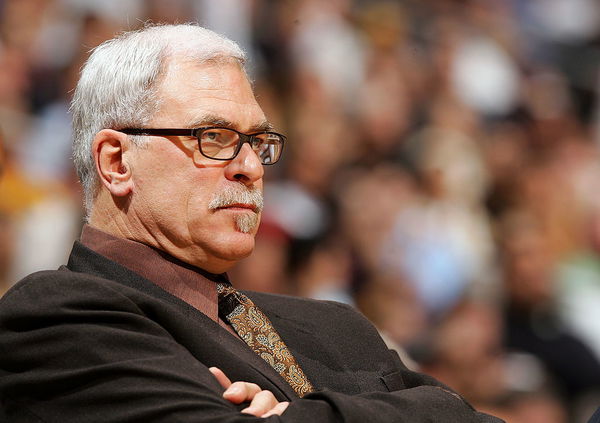
Imago
Feb 8, 2024; Los Angeles, CA, USA; Former Los Angeles Lakers head coach Phil Jackson speaks during a ceremony for the unveiling of a statue for former Los Angeles Lakers guard Kobe Bryant at Star Plaza outside of Crypto.com Arena. Joining him on stage are Vanessa Bryant and Stu Lantz. Mandatory Credit: Jason Parkhurst-Imagn Images

Imago
Feb 8, 2024; Los Angeles, CA, USA; Former Los Angeles Lakers head coach Phil Jackson speaks during a ceremony for the unveiling of a statue for former Los Angeles Lakers guard Kobe Bryant at Star Plaza outside of Crypto.com Arena. Joining him on stage are Vanessa Bryant and Stu Lantz. Mandatory Credit: Jason Parkhurst-Imagn Images
Have you ever wondered what it’s like to rise to the top of your field while dealing with immense physical pain? Phil Jackson, the legendary NBA coach and player, is a living example of such resilience. Known as the Zen Master for his calm demeanor and strategic brilliance, Jackson’s success was accompanied by years of physical challenges that began during his playing career itself.
Watch What’s Trending Now!
In his second year as an NBA player, Jackson herniated a disc in his lower back—specifically at L4-L5-S1. This injury was severe enough to require fusion surgery, sidelining him for an entire third season of his NBA career. But the repercussions didn’t stop there. The injury caused nerve damage in his right leg, leading to atrophy in the Soleus muscle. The part of the calf that controls movements like flexing the big toe. Imagine trying to play or even walk normally with that kind of setback.
As Phil Jackson transitioned to coaching, his physical issues persisted and eventually worsened. By 2006, while leading the Los Angeles Lakers, he described his pain as “debilitating” in a 2006 article by Los Angeles Times. At 61, Jackson had been walking with a limp for years, but the summer of 2006 brought things to a tipping point.
ADVERTISEMENT
“The pain got debilitating this summer,” he shared. “I could only exercise through swimming, which I enjoy immensely on the lake outside my doors.” For someone who had spent his life in the physically demanding world of basketball, resorting to swimming for basic activity must have been a stark reminder of his limitations. Yet, Jackson found motivation to push through. He had two daughters’ weddings that summer. And as he put it, “I kept my eye on the prize until I could get back here after Labor Day and go through some diagnostics.”

Getty
LOS ANGELES – FEBRUARY 13: Head coach Phil Jackson of the Los Angeles Lakers sits on the bench and watches the game against the Utah Jazz on February 13, 2006 at Staples Center in Los Angeles, California. NOTE TO USER: User expressly acknowledges and agrees that, by downloading and or using this photograph, User is consenting to the terms and conditions of the Getty Images License Agreement. (Photo by Lisa Blumenfeld/Getty Images)
Initially, he thought his back was the main culprit, as nerve pain radiated down his leg. However, specialists later confirmed that it was his right hip that was the real issue. A hip replacement followed, though his left hip also began causing trouble soon after. Fast forward to 2011, and Jackson finally decided to step away from coaching, marking the end of his iconic tenure with the Lakers.
ADVERTISEMENT
That year wasn’t the fairy-tale ending anyone envisioned. Internal team disruptions, coupled with Jackson’s health challenges, led to the Lakers being swept out of the playoffs by the Dallas Mavericks.
ADVERTISEMENT
Phil Jackson later opened up on the issues he was facing back in 2011
Jackson has often joked about being a “walking metal detector alarm,” because of the countless surgeries he has undergone over the years. But humor aside, his injuries never slowed his passion for basketball. After leading the Lakers to a historic three-peat in the early 2000s, Jackson returned to guide the team to back-to-back championships in 2009 and 2010. Yet by 2011, cracks were starting to show—not just with the Lakers, but with Jackson himself.
Let’s take a moment to imagine what that year must’ve been like for him. At 65, he wasn’t just dealing with nerve damage that had plagued him since his playing days. But in March 2011, he further received another terrible news—he was diagnosed with prostate cancer. Hard to even picture the weight of that. Coaching a championship-contending team while quietly fighting cancer. He still kept the diagnosis private, only sharing it with his team during their postseason run.
Top Stories
Did Luka Doncic Name His Son After Austin Reaves? Fact Checking The Viral Birth Photo

“Saved the Celtics Season”: Surprise 21YO Star Credited For Boston’s Resurgence After Locking UP Austin Reaves

JJ Redick Drops Return Update on LeBron James, Luka Doncic After 21-Point Celtics Loss

Is Bronny James’ Girlfriend Pregnant? Fact Checking The Viral Parker Whitefield News

JJ Redick Makes Bold Joe Mazzulla Claim After Lakers-Celtics


Getty
OKLAHOMA CITY, OKLAHOMA APRIL 24, 2010 Lakers head coach Phil Jackson has a few words with Kobe Bryant in Game 4 of the Western Conference Playoffs in Oklahoma City. (Photo by Wally Skalij/Los Angeles Times via Getty Images)
“That was probably my hardest year of coaching,” Jackson later admitted. “I was ready to retire. I’m dealing with a situation of a cancer operation at the end of the season. It was a fumble at the end, and it led to an uneasy feeling for the team.” And it showed—the Lakers were swept by the Dallas Mavericks, their championship hopes dashed.
ADVERTISEMENT
But Jackson’s resilience isn’t surprising when you think deep on his aforementioned history with injury. Yep, the spinal fusion surgery early in his playing career.
“I was in my second year as a player I herniated a disc L45S1 and I had to have a fusion I sat out for a year and have a fused lower back so that’s one of the reasons I probably sit like this. And as a result, I have atrophied nerve damage in the calf of my right leg here in the Soleus muscle which controls your toe your big toe and so there is a lot of things that emanated out of that,” Jackson shared in a conversation with entrepreneur JT Foxx.
ADVERTISEMENT
Phil Jackson’s journey reminds us that even legends face battles off the court. His story isn’t just about championships—it’s about perseverance in the face of adversity. If there’s one takeaway here, it’s that greatness is never without struggle, and Phil Jackson is the proof of that.
ADVERTISEMENT
ADVERTISEMENT
ADVERTISEMENT

